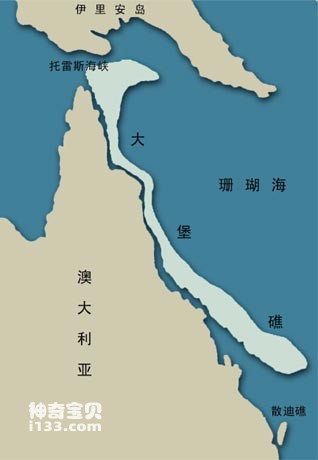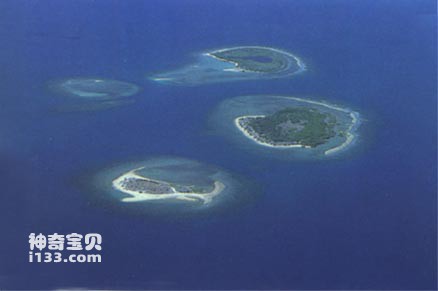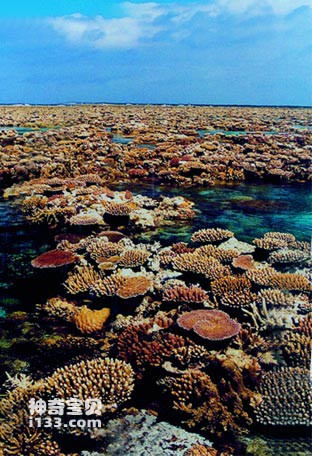In the South Pacific, between Australia, Papua New Guinea, the Solomon Islands, the New Hebrides Islands, New Caledonia and the 30th parallel south, there is a colorful sea called the Coral Sea. The Coral Sea is connected to the Solomon Sea to the north and the Tasman Sea to the south. It covers an area of nearly 5 million square kilometers and is the largest sea in the world. It is the marginal sea of the Pacific Ocean. This was once the world of coral polyps. They were so ingenious that they left behind the largest barrier reef in the world. Numerous atolls, coral stone platforms, like heavenly flowers and stars, are scattered on the vast ocean, hence the name Coral Sea.

Map of the geographical location of the Coral Sea
The Coral Sea is located in the tropics, and the water temperature is between 18-28°C all year round. The wind speed here is small, the sea surface is calm, and the water quality is clean, which is conducive to the growth of corals. It is famous for its numerous coral reefs. Here are three of the world's largest coral reefs, the Great Barrier Reef, Tagula Barrier Reef and New Caledonia Barrier Reef. The Great Barrier Reef is the largest and is located in northeastern Australia. The closest point offshore is only 16 kilometers and the furthest point is more than 240 kilometers away. The Great Barrier Reef lies there like a long belt, more than 2,000 kilometers long, 150 kilometers wide at its east-west point, and covering an area of about 80,000 square kilometers. Most of its reefs are submerged underwater, and those exposed above the sea become coral islands. More than 500 coral islands are scattered on the sea surface of more than 900 square kilometers, like a row of castles, guarding Australia's northeastern coastal defense. The island's dense tropical jungle is lush and green; next to it is a white and silver beach, and under the blue water outside the beach, you can see a colorful coral reef platform. There is ample sunshine, fresh air, clean sea water and rugged rocks, making it a paradise for marine life. The beautiful environment has become a good place for people to travel and sightsee. In 1979, Australia turned the Great Barrier Reef into a marine park, and many wealthy people invested and developed it here. On the larger islands, there are airports and ports, and there is an endless stream of tourists, making it easy to come and go by plane or cruise ship. People boat, swim, sunbathe and sand bath here. You can also sit in a tour boat with a glass bottom and enjoy the wonderful underwater world. A variety of fish and shrimps, and seashells of different colors will feast your eyes. The parrot fish covered in red and green ribbons is chewing coral; the crystal-clear trumpet fish is moving east and west on the water; the light and thin gill fish dares to aim at the hand that bites you; the big sea turtle with an arrogant look is in front of strangers. There is no need to panic; the underwater coral world, under the sunlight, is colorful in red, yellow, and blue; some are branch-shaped, some are brain-shaped, some are like wickers, or some are like flowers, and they are in various shapes and forms, which is fascinating.

Coral reef on the Coral Sea
Coral looks like a plant, but it is actually a kind of animal in the ocean. A piece of coral is often a colony of tens of billions of coral polyps. Living corals are colorful in the sea water, including yellow, green, purple, and red. The colors are bright and dazzling, and they are called flowers of the sea. The white coral we see every day is the remains and skeletons left behind after the coral dies. Coral polyps are so small that they can only be seen clearly under a microscope. It has no eyes or nose, only sensitive tentacles, which are its sense organs. The tentacles float slowly with the current, extending and contracting freely to capture plankton and debris flowing nearby. When frightened, it immediately retracts and hides its tentacles. In the center of the surrounding tentacles, there is a small mouth, which is the mouth of the coral polyp, called the "mouth". The mouth is just a rectum, without an esophagus or a stomach. It spits out the digested residue through its mouth. The anus and mouth are not separated, so it is not unfair to call it a lower animal.

Brilliantly colorful corals
Tiny coral polyps reproduce, neither like a hen laying eggs to hatch chicks, nor like a sow giving birth to piglets. The reproduction of coral is by division, and the speed is astonishing. It can divide into two, and two into four, and in the blink of an eye, there will be children and grandchildren. But they are all on a piece of coral. You are pressing me, I am squeezing you, and you can't tell the difference between the father and the younger generation. Some coral polyps also undergo sexual reproduction. Through the combination of sperm and eggs, floating larvae are produced, which are excreted through the mouth and drift with the water. When they encounter a suitable place, they attach and establish a foothold, develop into coral polyps, and gradually grow into a colony. Colonial corals reproduce very quickly, and the old ones continue to die, leaving behind skeletons and becoming reefs; new coral polyps continue to climb on the bones of their predecessors. In this way, the predecessors fell down and became paving stones, while the younger generations stepped on the bones of their predecessors and continued to build new peaks. Coral reefs are built like this. The Great Barrier Reef and other atolls and islands have also gone through this process.
Not all corals can build reefs. Only corals that contain calcareous matter in their bodies, such as stony corals, staghorn corals, multi-branched rose corals, etc., have this ability. Also contributing to reef building are the zooxanthellae in corals, which are single-celled algae that are so small that 1,000 zooxanthellae together would be as big as a grain of rice. It performs photosynthesis in the sun, absorbs carbon dioxide, releases fresh oxygen, and turns nitrogen, phosphorus, and potassium into organic matter, which serves as nutrients to supply the growth needs of coral polyps, making the coral vibrant and beautiful. When the environment becomes cold and cold, the zooxanthellae will escape and the coral will lose nutrients and soon become dull, wither and die. There are so many coral reefs preserved in the Coral Sea now, which shows that during the era of reef building, there were not only a large number of reef-building corals, but also strong zooxanthellae breeding and growing here. Their successful cooperation makes the Coral Sea so colorful.
animal tags:
We created this article in conjunction with AI technology, then made sure it was fact-checked and edited by a Animals Top editor.